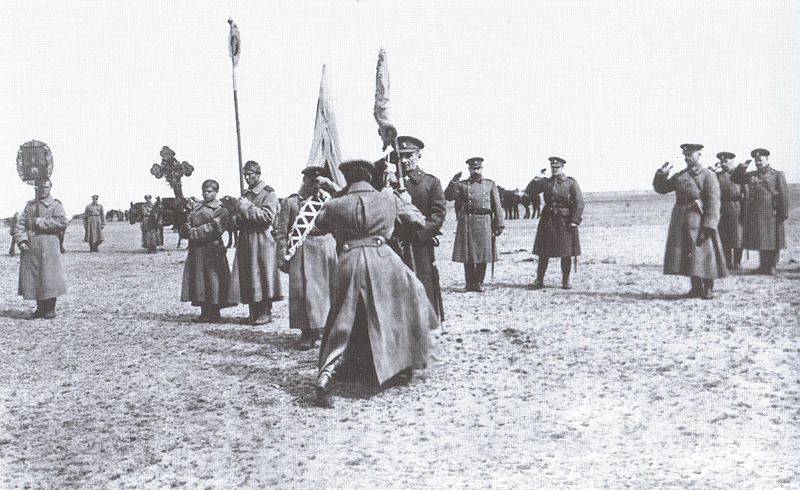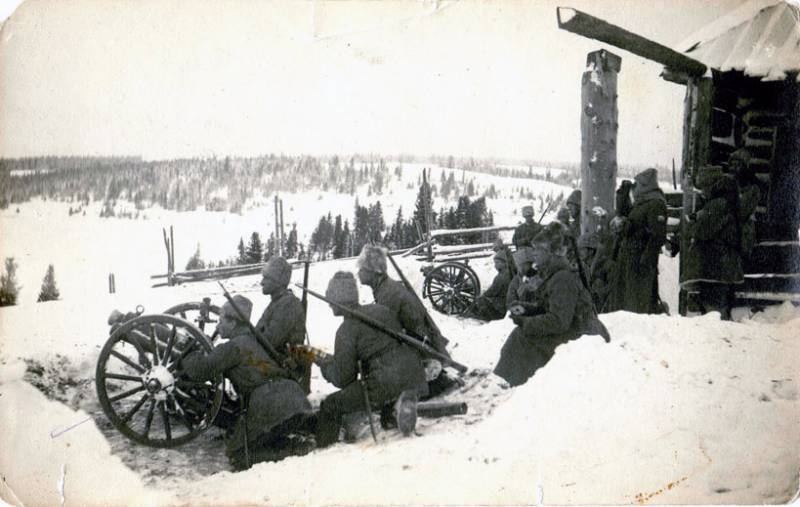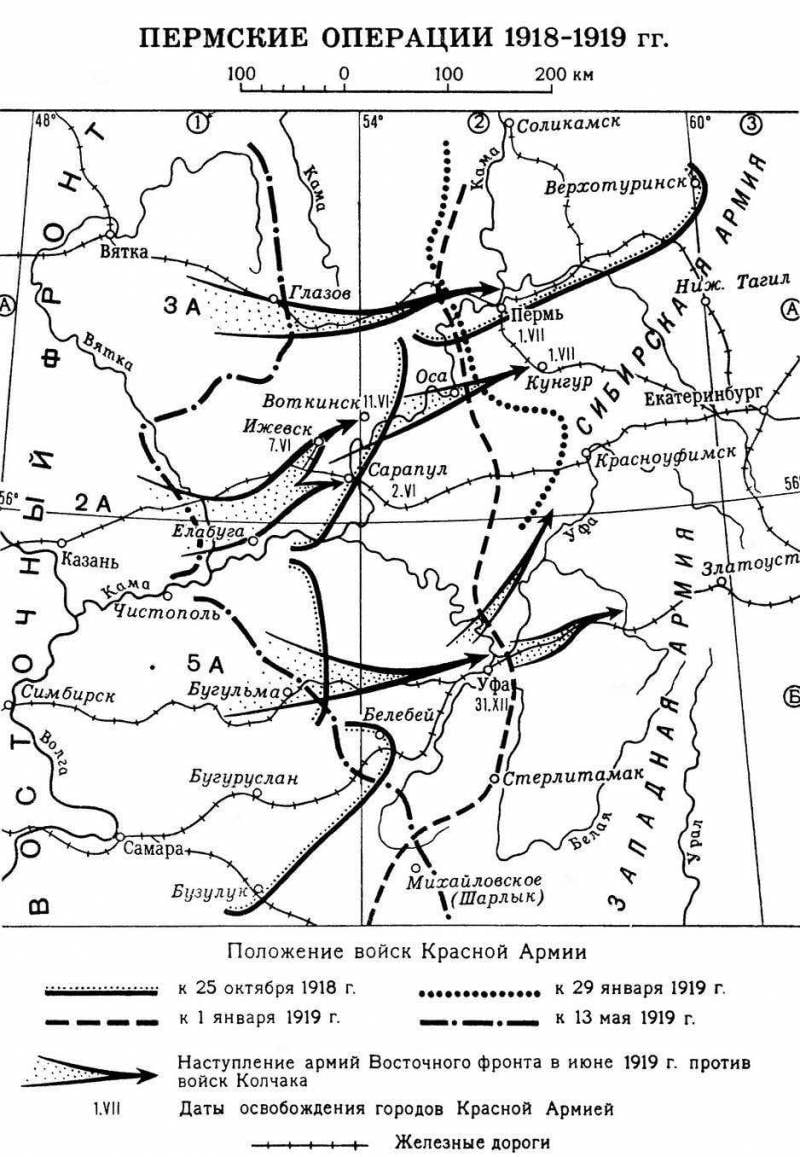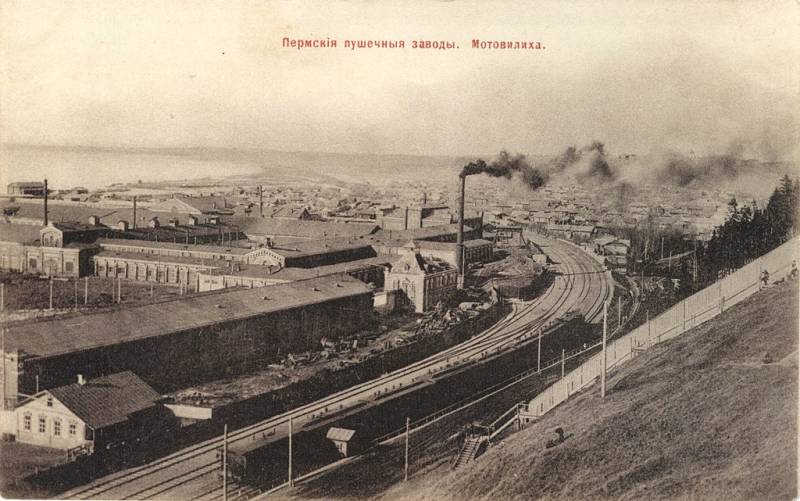"Perm disaster"
Situation on the Eastern Front
By the beginning of November 1918, the Red Army on the Eastern Front achieved serious success: on the right flank (4-I Red Army), in the center (1-I and 5-I armies). At the same time, the 2 Red Army occupied the Izhevsk-Votkinsk District (How to suppress the Izhevsk-Votkinsk uprising; Sturm Izhevsk), which the wedge entered the red front and for quite a long time connected considerable forces of the Reds, restricting their operational freedom. These successes were accompanied by the disintegration of the Directorate’s troops, especially in the Ufa area. The 3 th Red Army, which had opposed the main enemy forces, was in a more difficult position. However, the defense was stable, and the Reds achieved a number of private successes.
Thus, the overall situation at the front was favorable for the Reds and made it possible to develop the offensive during the new campaign. Therefore, the main command of the Red Army decided that the crisis on the Eastern Front was overcome and it was possible to strengthen other fronts at the expense of its troops, mainly the Southern. At the same time, only the right flank of the Eastern Front was weakened; the left, that is, the 3 Army, was strengthened - the 5 and 7 rifle divisions and the brigade of the 4 rifle division. So, November 6 proposed to separate the entire 1 Army from the Eastern Front to reinforce the Southern Front. At the same time, in the rear, mid-flight reinforcements began to be sent not to the Eastern, but to the Southern Front. The new units formed in the rear of the Eastern Front also redirected. For example, on November 4, the 10 rifle division, which was completing the formation in Vyatka, was ordered to be transferred to the Tambov-Kozlov region, to be sent to the Western Front.
At the same time, the Red Army continued its offensive on the Eastern Front. This was due to a number of factors. First, it was connected with the force of the initial blow of the Reds in the Ufa direction, which they inflicted on the whites. Secondly, there was a process of internal decomposition of the army of the Directoire, its combat effectiveness has fallen sharply. Third, the Czechoslovak units, which were the core of the white army, began to leave the front line. The Czechs, who sympathized with the social-democratic government, did not support the military coup in Omsk, but under pressure from the Entente did not oppose the coup. In addition, they were tired of the war and no longer wanted to fight when they received the news of the surrender of Germany. The slogan "home" has become the most popular among Czech legionnaires. They began to leave the front, and after leaving the military atmosphere the Czechoslovak army quickly decomposed, the main activity of the legionnaires was personal and collective enrichment before returning to their homeland. Their military trains now resembled freight trains full of various good things stolen in Russia.
Therefore, in November, all the armies of the Red Eastern Front continued their offensive, except for the 3. So, from 11 to 17 in November 1918, the Reds advanced on the Orenburg direction to two transitions to Orenburg. Also the Reds were advancing in the Ufa direction, attacking Birsk in the Menzelinsky direction, they took the city of Belebey. In the Votkinsk direction, after the capture of Votkinsk 11 - November 13, the Reds forced the Kama. Only in the Perm region fights went with varying success.
Only in early December, the situation has changed. In the Ufa direction, White launched a counterattack, trying to restrain the Reds. In the area of Belebey, fierce battles started, he was temporarily lost in red. On the Sarapul sector, the 2 Army continued to slowly develop success, occupying a wide lane on the left bank of the Kama. At the site of the 3 Army, the Whites began to crowd the Reds.
After the military coup of 18 in November of 1918, when, under the conditions of complete military and economic insolvency of the Social Democratic Provisional Government (Directory), the military, with the consent of the Entente, appointed the “supreme ruler” Admiral Alexander Kolchak. The dictator retained the White Czechs' military strategy: the advance of the main army forces in the Perm-Vyatka direction, access to Vologda, in order to connect with the northern parts of the whites and the interventionists, to gain access to the ports of Arkhangelsk and Murmansk. In fact, Kolchak inherited the military plans of the Czechoslovak command, which sought to find a closer way to Europe (northern ports) than Vladivostok. This idea was supported by the Entente and it was followed by General Vasily Boldyrev, Commander-in-Chief of the Directorate forces. November 2 General 1918 prepared a directive on the offensive of the Yekaterinburg group of the Siberian Army to capture Perm and reach the line of the Kama River.

Supreme Ruler A. V. Kolchak hands the regimental banner. 1919
However, in fact it was a strategic impasse. The White Command, due to the interests of the Entente, neglected the main operational direction (toward Moscow) and the more important southern, where it was possible to establish contact with strong armies of the White Cossacks on the Don and Kuban (through the Volga and Tsaritsyn). The northern direction was very extensive and absorbed the main strike force of the White Army, communications here were less developed. By the time of Kolchak's offensive, the northern front of the Entente and the Whites was finally constrained by the onset of winter and could not help the Kolchak troops with a counterstrike. Even with the full success of the operation and the connection of the Eastern and Northern anti-Bolshevik fronts, whites received vast areas with a small population and a weak economic (industrial and agrarian) potential. The Bolsheviks retained control over the most developed central part of Russia. The northern front was too weak to seriously enhance the combat potential of Kolchak's army. The invaders did not want to go deep into Russia and did not want to be in the first roles in battles with the Reds. The West was solving the problem of fomenting a fratricidal civil war in Russia, and was not going to use its troops for decisive operations on the vast Russian expanses. Not surprisingly, the Czechoslovak units, which were under the control of the Entente, soon left the White Guard front, which also affected the activity of the Kolchak army.
The 2 Red Army, under the command of V.I. Shorin, consisted of 9,5 thousand bayonets and sabers with 43 guns and 230 machine guns. The M.N. Lashevich's 3 Army had more than 28 thousand bayonets and sabers with 96 guns and 442 machine guns. They were opposed by the Ekaterinburg and Perm groups of the Siberian Army: more than 73,5 thousand bayonets and sabers, 70 guns and 230 machine guns.
Artillery of the White Czechs near Kungur
Perm operation
November 29 1918 of the year, White launched the Perm operation. The offensive was launched by the Yekaterinburg group of the Siberian Army (1 of the Central Siberian Army Corps of General A. Pepeliaev and the 2 of the Czech division), numbering about 45 thousand fighters. 3-I red army under the onslaught of superior enemy forces begins to lose its stability. November 30 Reds leave Vyya station, depart to Kalino and Chusovaya stations. White breaks through the front of the 3 army. December 11 Kolchak take the Lysva plant, December 14 come to the line Chusovoy plant - Kungur. Reds are trying to stop the enemy at the turn of the river. Chusovaya, but due to heavy losses (up to half of the personnel) and weak combat capability of the units, they continued to retreat to Kungur and Perm.
It should be noted that the main reason for the rapid defeat of the 3 th Red Army was not its numerical weakness compared to the enemy, but qualitative weakness. By this time, the army had enough reserves, but its best personnel from the Ural proletariat were already knocked out, and the influx from the center of the country from relatively well-trained and disciplined, politically literate units ceased. The 3 Red Army was replenished with marching battalions with companies from the mobilized peasants of the Vyatka and Perm gubernias, which were distinguished by weak combat and political training. They only decomposed the rest of the troops, not reinforcing them. Also among the reasons for the defeat of the Reds note: the length of the front (400 km), lack of food and fodder, natural conditions (hard frosts, deep snow) in the face of lack of winter clothing, shoes, fuel and vehicles.
December 15 Corps Pepeliaeva, pursuing the 3 th army, occupied the station Kalino and Chusovaya. The command of the red 3 Army had still strong quantitatively, but obviously, weakly qualitative reserves. The forces of the 29 and 30 divisions of the rifle divisions occupied random positions in a continuous wooded and swampy area with a length of 40 - 50 km, which covered Perm from the north and east. Therefore, there were strong breaks in the red defense line. The Red command from Perm reinforced its left flank with three regiments of local formations from the special division (up to 5 thousand) and the Separate Kama Brigade (2 thousand fighters). The reinforcement of the 29 division from Perm sent several echelons of the 4 division of the Urals. Then, the last army reserve, the brigade of the 4 Ural Division, was withdrawn from Perm. As a result, the 3 Army was left without reserves, which were used to no avail, and Perm without a garrison and proper defense. The Whites used the enemy’s mistakes and the wooded area in order to break through to Perm between the separate sections of the defense of the 3 Army, which was formed due to the betrayal of one of the new regiments.
December 24 Kolchak united the Yekaterinburg and Perm groups into a new Siberian army under the supervision of R. Gaida. December 21 Kolchak took Kungur. On the night of 24 on 25 December, the White Guards captured Perm. The Reds left the city without a fight and ran along the railway line to Glazov. The Kolchak army captured the reserve battalion of the 29 Infantry Division, large reserves and artillery - 33 guns. White on the move forced the Kama and seized a large bridgehead on its right bank. There was a threat of a breakthrough of Kolchak's troops to Vyatka and the collapse of the entire left flank of the Red Eastern Front. However, soon the successful offensive of the Siberian army on the Perm direction went out. December 27 due to the success of the 5 Red Army in the Ufa direction, the White command stopped the attack in the Perm direction and began withdrawing troops to the reserve. The front of the 3 Red Army stabilized in front of Glazov. On December 31, Kolchak began the formation of a new separate Western army under the command of General M. V. Khanzhin (as part of the 3 Urals Corps, Kama and Samara Army Groups, later on 8 Ufa and 9 Volga Corps), to act on Ufa direction.
The High Command of the Reds drew attention to the crisis situation in the sector of the 3 Army. 10 December 1918 of the year it ordered to restore the position at the front, and parry the enemy's strike on Perm by maneuvering the forces of the 2 and 5 armies. However, 3-I army could not restore the situation due to the lack of front reserves, which could immediately be thrown into battle on a dangerous direction. And the results of the operations of the 2 and 5 armies could not immediately affect the sector of the 3 armies. Therefore, the Reds continued to conduct stubborn oncoming battles and in some places to advance in the Orenburg, Ufa and Sarapul directions to the east, and the 3-I army continued to retreat. December 14 the main command in connection with the crisis in the area 3-th army sets the task of the Eastern Front to develop an offensive on the front of Yekaterinburg - Chelyabinsk. On December 22, the High Command again instructed the 2 army to come to the aid of the 3.
After the fall of Perm, the main command took measures to strengthen the defense of Izhevsk and Votkinsk. The 2 th Red Army was categorically ordered to stop the advance to the east and turn north to act in the flank and rear of the Perm enemy group. December 27 decided to leave the 1 Army on the Eastern Front, canceling its transfer to the south. December 31 5 Red Army troops took Ufa, creating threats of a breakthrough of the white front. 6 January 1919 of the year Kolchak confirms the transition of troops to defense in the Perm area, and sets the goal to defeat the red group in the Ufa area and recapture the city.
In mid-January, the Red Command 1919 organized a counter-offensive in order to recapture Perm, Kungur and restore the situation at the front. The operation was attended by troops of the 3 Army (more than 20 thousand bayonets and sabers) and the 2 Army (18,5 thousand people), which was reinforced by the 7 Rifle Division's brigade from the reserve of the High Command and two regiments from 5 army. Also an auxiliary strike on Krasnoufimsk was delivered by the shock group of the 5 Army (4 thousand people), which in the Ufa area turned to defense by the main forces. January 19 The 1919 of the year launched the 2 army from the south and the strike group of the 5 army, January 21 - the 3 army. The operation did not lead to success, it affected: haste in organization and slowness in regrouping, lack of superiority in forces in the 2 Army, and also harsh winter conditions. By January 28, the 2 Red Army advanced to 20 — 40 km, the 3 Army — to 10 –20 km, the 5 Army's strike group to 35 - 40 km. Red troops could not create a serious threat to the Perm group of whites. Unable to break through the front of the enemy, the Reds went over to the defensive.
Map Source: Sovetskaya historical encyclopedia
Results
Kolchak's army, on its right flank, broke through the red front and defeated the 3 Army, captured Perm and Kungur. The first stage in creating a connection with the Northern Front through Vyatka and Vologda was successfully implemented. White captured a large urban center and important Motovilikhinsky factories, as well as a serious communications hub - water, railway and unpaved roads.
However, the further development plan of the offensive of the white command did not receive. This was due, firstly, to the measures of the red command. December 31 Red 5-I army took Ufa. Kolchak was forced to stop the attack on the Perm direction. The White Siberian Army went over to the defensive, repelling the Reds' counter-offensive and preparing a new strike in the Ufa direction.
Secondly, this was due to the strategic mistake of the white command. White stepped on the rake a second time, advancing in the northern, Perm direction. This direction, due to its vast space, climatic and local conditions (swamps and continuous forests), small population and weak economic potential, greatly hampered offensive operations and absorbed the strike forces of the White Army. In addition, the Northern Front of the invaders and the whites by this time was constrained by winter conditions and could not help the army of Kolchak. A part of the Czechoslovakia by this time left the front.
Thus, the first success of the whites did not lead to a decisive result, and the neglect of the white command to the main operational direction soon led Kolchak's army to a general defeat.
In the Soviet leadership, the loss of Perm became a pretext for the inner-party struggle: Lenin-Stalin against Trotsky-Sverdlov. Lenin used the situation to restore his position as the leader of the party and the commander-in-chief, who were shaken after his injury and temporary absence on the political Olympus. Also, the “Perm disaster” became the next stage after the Tsaritsyn conflict in the confrontation of Stalin and Trotsky. Even before the Perm operation, the people's commissar for military affairs and the chairman of the Revolutionary Military Council of the Republic, Trotsky came into conflict with the local Bolsheviks and the leadership of the 3 army, demanding to punish the commissars who were to follow the military specialists (in particular, in the summer of 1918, the commander of the 3 th army B. Theological switched to the side of the whites). Then Stalin and Dzerzhinsky were assigned to investigate the events of the “Perm catastrophe”.
5 January 1919 of the year Central Committee members arrived in Vyatka - the headquarters of the 3 Army. After conducting an investigation, they placed responsibility on the Revolutionary Military Council and the command of the 3 Army. Among the reasons for the defeat identified by Stalin and Dzerzhinsky were: errors of the army command, decomposition of the rear (began arrests of suppliers who were found to be negligent, inactive, drunkenness and other official crimes); weak local party and soviet organs (their cleaning and strengthening has begun); The "clogging" of the army by "class alien, counterrevolutionary elements" (Dzerzhinsky tightened the policy towards military experts); lack of human and material reserves, poor material supply of the army. The party-investigative commission also noted the errors of the RVSR led by Trotsky, in particular, the lack of establishing normal interaction between the 2 and 3 armies. Lenin praised the work of the commission. Later, in 1930 - 1940-ies, Soviet historiography began to evaluate the activities of Trotsky in this episode of the Civil War as treacherous.
Perm cannons in Motovilikha. Photo source: https://ru.wikipedia.org



Information